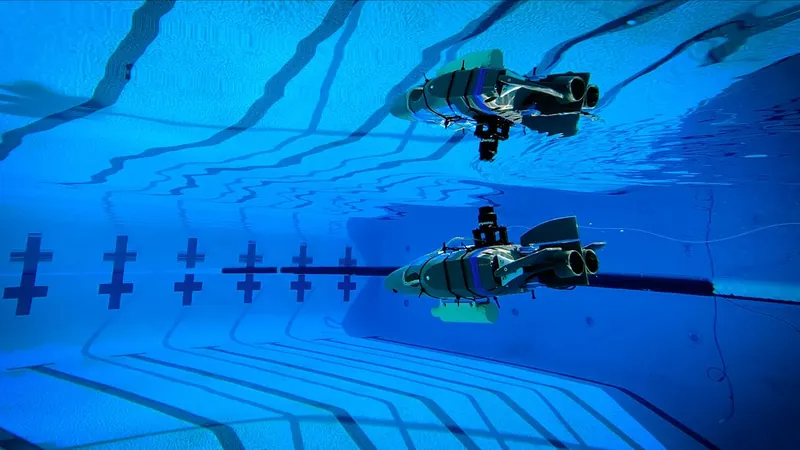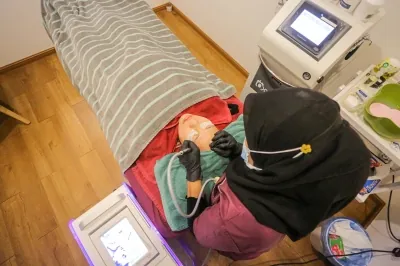
NASA’s Revolutionary Underwater Robots: The Future of Alien Exploration!
2024-11-24
Author: Arjun
Introduction
In an exciting leap for space exploration, NASA has begun testing a groundbreaking swarm of miniature robots, aptly named SWIM – Sensing With Independent Microswimmers, designed to search for life in the hidden oceans of extraterrestrial worlds. Recently, these robots showcased their remarkable capabilities in tests conducted in a swimming pool at the prestigious California Institute of Technology (Caltech).
Capabilities of SWIM Robots
The SWIM robots, resembling compact wedges and powered by propellers, proved their dexterity by effortlessly navigating through water, performing intricate maneuvers including a back-and-forth “lawnmower” pattern, and even spelling out “J-P-L.” Such agility raises hopes for their applications in the icy depths of Jupiter’s moon, Europa, where scientists believe a salty ocean lies beneath its frozen surface—an ocean that might harbor alien life.
Purpose of Development
Ethan Schaler, the principal investigator at NASA’s Jet Propulsion Laboratory (JPL), posed an intriguing question: “Why is NASA developing an underwater robot for space exploration?” His answer underscores the necessity—“Because the exploration sites we aim for in the solar system are environments where water is essential for life.”
Design and Future Iterations
The SWIM robots, currently measuring about 16.5 inches long, are crafted from 3D-printed materials and utilize off-the-shelf motors and electronics to keep costs manageable. Future iterations aim to shrink these marvels to the dimensions of a smartphone, approximately 5 inches in length.
Communication System
A robust wireless communication system is also planned to help these underwater explorers relay vital data back to Earth, a crucial feature in the vastness of space.
Testing and Troubleshooting
During the pool trials, the robots were securely tethered to a fishing line, ensuring they could be recovered after each of the 20 tests conducted in a controlled 25-yard pool environment. This innovative approach was crucial for troubleshooting potential issues.
Challenges Ahead
Schaler emphasized the complexity of underwater robotics, stating, “Underwater robots in general are very hard, and this is just the first in a series of designs we’d have to work through.” The initial testing phase is vital in determining the challenges these robotic explorers may face when venturing into uncharted waters on cosmic missions.
Advancements in Simulation
Meanwhile, engineers are advancing the development of SWIM robots in computer simulations that mimic the extreme pressure and zero-gravity conditions of the moons. This allows researchers to refine robot designs and enhance their scientific capabilities for gathering data in unfamiliar terrains.
Multi-Sensor Chip Integration
A groundbreaking addition to the SWIM project is a cutting-edge multi-sensor chip designed by Georgia Institute of Technology engineers. This tiny chip measures crucial indicators such as temperature, pressure, acidity, conductivity, and chemical composition—key metrics in the pursuit of extraterrestrial life.
Conclusion
The stakes couldn’t be higher; with each test and development phase, NASA takes one step closer to unraveling the mysteries that lie beneath the icy surfaces of our solar system's ocean worlds. Will these tiny robots unveil the secrets of the universe and prove that life exists beyond Earth? Stay tuned as the future of space exploration gets a revolutionized dive!






 Brasil (PT)
Brasil (PT)
 Canada (EN)
Canada (EN)
 Chile (ES)
Chile (ES)
 España (ES)
España (ES)
 France (FR)
France (FR)
 Hong Kong (EN)
Hong Kong (EN)
 Italia (IT)
Italia (IT)
 日本 (JA)
日本 (JA)
 Magyarország (HU)
Magyarország (HU)
 Norge (NO)
Norge (NO)
 Polska (PL)
Polska (PL)
 Schweiz (DE)
Schweiz (DE)
 Singapore (EN)
Singapore (EN)
 Sverige (SV)
Sverige (SV)
 Suomi (FI)
Suomi (FI)
 Türkiye (TR)
Türkiye (TR)